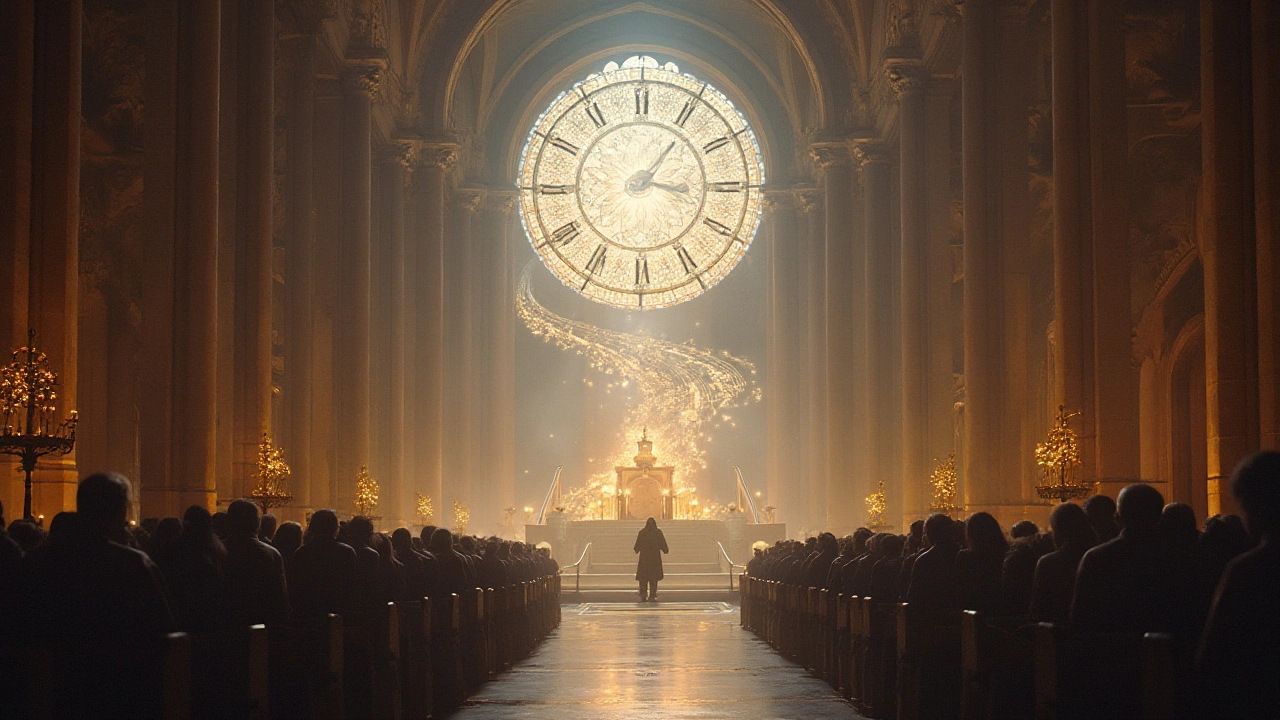The world of music has its fair share of ambitious projects, but few can match the grandeur of a song set to play for an entire millennium. This might sound like science fiction, yet such a piece exists in the form of 'Longplayer.' Conceived with the intent to run uninterrupted for a thousand years, Longplayer challenges our conventional understanding of time and music.
Unlike any other musical endeavor, this project is a living, breathing composition that's designed to evolve without ever looping the same note sequence. It’s an audacious experiment that doesn't just push the boundaries of technology but also philosophy, posing big questions about the permanence of art and the passage of time.
- The Origin of Longplayer
- How Longplayer Works
- Philosophical Implications
- Impact on Musical Landscape
- Experiencing the 1000-Year Song
The Origin of Longplayer
In the late 1990s, an intriguing concept began to take shape in the mind of Jem Finer, a founding member of the British band The Pogues. Finer wasn't just a musician; he was a thinker drawn to the deep connections between time, sound, and the cosmos. This fascination blossomed into the bold idea of creating a piece of music that would span an entire millennium, thus giving birth to what we now know as Longplayer. The vision was to stretch beyond the typical constraints of a song or album, transcending the familiar boundaries of musical projects.
Longplayer officially began its journey on December 31, 1999, perfectly timed to usher in the new millennium. The project was hosted at the Trinity Buoy Wharf Lighthouse in London, a fittingly timeless setting for such an ambitious endeavor. As the clock ticked into the 21st century, Finer's complex and meticulously crafted score started its eternal loop, its notes designed to blend into an ever-evolving tapestry of sound. The music, although played continuously, was uniquely curated to change and never repeat in its entirety for 1,000 years, a creative challenge that stands as a testament to human innovation and endurance.
Finer's work wasn't just an artistic foray but a carefully engineered construct, relying heavily on mathematical permutations. He utilized a series of Tibetan singing bowls, creating layers of sound that would cyclically shift over time. This ensured the uniqueness of the musical project. It's a combination of simplicity and complexity, where the interactions over time yield an astonishing variety of sound patterns.
The philosophical underpinnings of Longplayer dovetail seamlessly with its structural design. By existing within this expansive timeframe, the piece invites contemplation over themes of impermanence and continuity. It's less about the ordinary listening experience and more about the passage of time, asking us to consider our place in the universe amidst this endlessly shifting soundscape. Longplayer is a reminder of what it means to create something purposefully exhaustive yet beautifully intricate.
This breadth of ambition has garnered attention far beyond the musical sphere itself. The project has inspired discussions about art's role in society over protracted periods, demonstrating that an artwork can be a living entity, reacting to and reflecting change. Finer himself once remarked,
"Longplayer presents a radical reconsideration of the visible limits of art and music... It stretches our perception of these concepts over an almost inconceivable expanse of time."Such ideas position Longplayer as much more than a performance piece; it's a challenge to cultural and artistic norms.
How Longplayer Works
The marvel of Longplayer lies in its blend of creativity and technology, resulting in a seamless 1000-year-long composition. At its core, Longplayer operates using a composition by Jem Finer, which is meticulously arranged to prevent repetition over its millennium-long lifespan. The key to this perpetual piece is an ingenious algorithm that directs a set of six overlapping, yet variable, tracks. These tracks shift and combine in ways calculated through complex permutations to ensure that the music remains unique. The outcome is a meditative, ever-evolving soundscape that captivates and challenges listeners' perceptions of time and continuity.
A fascinating aspect of Longplayer is not just the music itself, but the mechanism behind its perpetual motion. Traditional methods of composition and performance were adapted to meet the demands of this lip-running song. The piece is layered with Tibetan singing bowls that produce harmonics, adding depth and texture to the sound. The bowls are struck in sequences determined by the algorithm, meaning the exact configuration will not repeat even once throughout the 1000 years. This creates a piece of music that's not only infinite but also organic, continuously interacting with listeners in new and surprising ways.
Longest song endeavors like these require innovative thinking, and Longplayer is no exception. The project utilizes timekeeping algorithms that account for the steady wear and tear of mechanical elements, ensuring that the pace and sequence of the music do not falter over the century-spanning performance. This forward-thinking approach means the team behind Longplayer had to anticipate every conceivable issue, setting precursors for future long-duration artistic endeavors.
"Longplayer is a way to interact with time, to explore its vastness and intricately weave it with music," notes composer Jem Finer, capturing the profound essence of the project.The intricacy and ambition of such an undertaking spotlight humanity's desire to create timeless art that transcends immediate generations.
The Technical Backbone
Delving deeper into the technical aspects, Longplayer is hosted on a blend of traditional broadcast methods combined with digital streaming services. This hybrid system ensures that the piece remains accessible to listeners around the globe, mirroring how the song itself bridges eras seamlessly between analog and digital milieus. A series of computers are employed to calculate and broadcast the sequence, each stepping in as a safeguard against any technological failures. Strategically, this approach guards against both the redundancy of data and potential platform obsolescence, making it a robust choice to span centuries.
A unique feature of the Longplayer system is its transparency and adaptability to changes, reflecting a design that anticipates advancements in technology while safeguarding the original vision. This adaptability ensures that as technology evolves, Longplayer can evolve along with it, potentially seeing enhancements in its broadcast or even the way listeners can engage with the sound. This harmonic resilience indicates that Longplayer is not only a song for the present but one that invites future interpretation and interaction, maintaining its relevance across ages.

Philosophical Implications
The creation of Longplayer confronts us with profound philosophical implications that stretch beyond music into the realms of art, time, and human cognition. This remarkable piece functions not just as a play on sound but as a meditation on the ephemeral and the eternal. Imagine, for a moment, a song that outlasts the lives of its creators and listeners; it’s a testament to human curiosity and our desire to leave a lasting impact upon the world. It provokes contemplation about legacy, asking us to reflect on what it means for art to be immortal, or if art should even strive for such a state. What happens to a musical piece when its duration far surpasses the life span of the average human? Does it become a timeless fixture in culture, or might it become forgotten, merely a curiosity of time passed?
The design of the 1000-year piece is not a mere technical challenge; it's a journey into the metaphysical. One might ponder how art can serve as a vehicle for understanding time not as a linear construct but as a cyclical and enduring presence. The song's persistent yet evolving structure embodies this cycle, relentlessly moving forward yet capturing echoes of the past. An interesting perspective from Brian Eno, renowned for his ambient music, surfaces here: he expressed that music is capable of making time tangible, almost like shaping it into a sculpture. This power of music resonates with Longplayer, challenging us to perceive music as a flowing continuum rather than discrete performances.
“In music, time becomes elastic, its boundary stretching and folding upon itself, blurring the distinction between past, present, and future.” – Brian Eno
Not only does Longplayer encourage philosophical inquiries into the nature of time and art, it also interrogates the ethics of preservation. How can one ensure that a project of this magnitude persists through political, technological, and environmental changes for 1000 years? It questions our responsibility to future generations in caretaking this piece of musical history, placing the onus on humanity to decide what to preserve and what to allow to perish. The Longplayer is not simply a song; it is a living artwork that challenges us to think deeply about permanence and change, reminding us that while we are individually ephemeral, together we might construct something of true immortality.
Impact on Musical Landscape
The creation of Longplayer has left an indelible mark on the musical landscape, challenging traditional forms and pushing artistic boundaries. This ambitious project redefines what it means to create and consume music by offering an experience that spans a full millennium. It forces listeners, artists, and critics alike to reconsider how they interact with music and its place in the cultural narrative. By designing music to exist continuously over a thousand years, Longplayer elegantly intersects with concepts of time, movement, and permanence.
The challenge of creating such a piece provokes conversations about technological advancements needed to sustain it and inspires innovation within the field. The persistence and dedication required to keep Longplayer running simulate the potential longevity of other musical works or projects. Artists are driven to ponder whether their work could, or should, endure in such an infinite manner. Longplayer acts as a catalyst for considering how music might function in eras deeply unfamiliar from our present or past.
Not only does Longplayer broaden artistic horizons, but it also invites a philosophical exploration of our relationship with music as an immortal form. The project offers a metaphorical mirror reflecting the infinite nature of music and its potential to stick around longer than the societies and cultures that created it. This impactful endeavor presents music as an entity that can exist independently of human interference, capturing moments in time as they perpetually slip into the future.
Tristan O'Neill, a prominent figure in music theory, remarked, "This project holds up a lens to time itself, allowing us to experience it through an auditory tapestry that is unlike anything ever conceived."Such insights serve as philosophical exchanges that engage listeners in considering the temporal depths art might embrace.
The notion of a 1000-year song also demonstrates how music can act as a living, breathing challenge not just to its creators but to our classic interpretation of musical experience. The piece blurs the lines between performance, installation, and audial journey, influencing composers to weave more intricate, long-term structures in their work. Issues such as sustainability, progression, repetition, and variation come to the forefront, encouraging breakthroughs in how music might evolve apart from human control. This enduring piece compels us to reflect on music's ability to persist and transform, proving that while musicians may change over the centuries, the core pleasures provided by creativity and innovation stay constant.

Experiencing the 1000-Year Song
Imagine stepping into a realm where the passage of time is marked not in minutes or hours, but in the gentle, unfolding continuum of a single, evolving piece of music. This is the unique experience offered by Longplayer, a musical project that aims to stretch across an entire millennium. Though it sounds almost mythical in nature, it exists as a testament to human ingenuity and a deep-seated desire to transcend temporal limits. Located at various listening stations around the world, Longplayer plays its harmonics through a web of both digital and physical mediums, making its ethereal journey accessible to listeners everywhere. As you listen, it's as if you become part of a conversation that spans generations, an auditory bridge that defies the conventional constraints of time and technology.
For those curious about how this remarkable piece is heard, modern technology plays a crucial role. Longplayer streams through the internet, ensuring that no matter where you are, you can tune into this composition that echoes across centuries. Set up at various physical locations, these listening posts invite audiences into spaces where the music plays continuously. The unique music piece has become a part of several museums and cultural institutions, allowing anyone to walk in and be embraced by its soft, resonant sounds. Each note of Longplayer is part of a vast ocean of sound, contributing to an ever-expanding musical tapestry that never repeats, never grows stale, yet somehow seems to echo a familiar lullaby we've all heard somewhere in our distant past.
The way we experience Longplayer challenges traditional listening habits. Typically, we'd lean back and let a song take us on a journey, bookended neatly by its start and finish. But here, there is no definite beginning or end. Instead, Longplayer exists as a living organism, continuously growing, never repeating the same pattern. This presents an intriguing paradox: the music is as familiar as it is unpredictable, a combination that keeps listeners engaged and mesmerized. As Jem Finer, the creator of Longplayer, reflects, "The project explores the great labyrinth of time"—a sentiment that captures its deep, philosophical core perfectly.
But an awe-inspiring aspect of this project is its emphasis on inclusivity and global engagement. Whether you stand in a dedicated space or listen from the comfort of your home, Longplayer welcomes everyone. It encourages us to ponder our place in the grand narrative of time. The project isn't merely about sustaining a sonic experience; it's about creating a shared heritage that links disparate moments with a continuous thread of music, fostering a sense of community across both time and geography. This unified sense of connection is profound, as each listener contributes to a shared experience that will last longer than any individual lifespan, a legacy in sound for a thousand years to come.
There’s a certain magic to its simplicity. Longplayer's structure, based on six interwoven sections of Tibetan singing bowls, uses mathematical permutations to create variation. While that might sound complex, the listener needn't worry themselves too much with the intricacies. What matters is how these elements weave seamlessly into an experience that is both humbling and awe-inspiring. You find yourself not just listening to music, but participating in an auditory journey that encourages introspection and an appreciation for the subtle changes and constancies of life.



